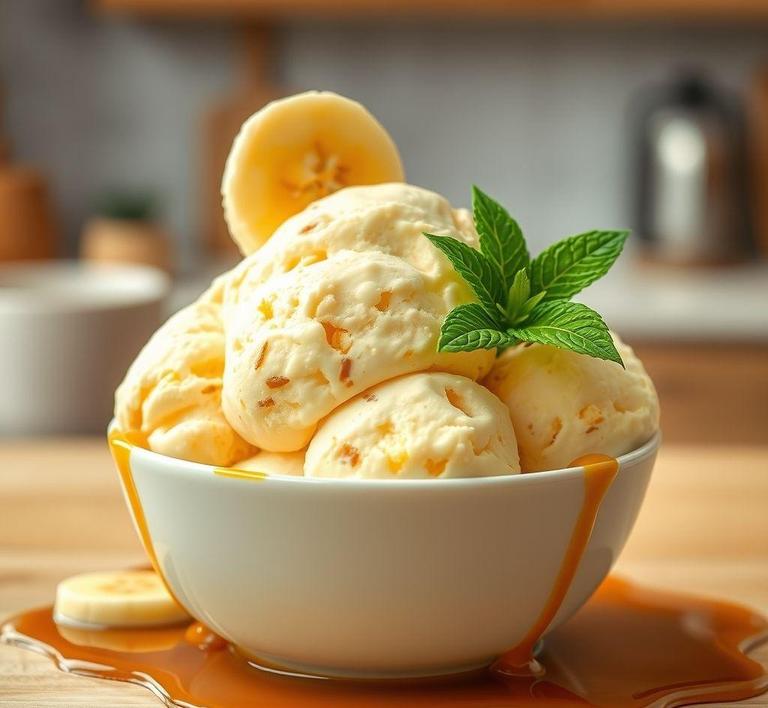Have you ever made banana ice cream and found yourself with a little too much leftover? Or maybe you’re wondering if it’s even possible to refreeze banana ice cream without it turning into a mushy mess? Well, good news! Refreezing banana ice cream is totally doable, but it does require a few simple tricks to maintain that creamy, smooth texture. Whether you’re trying to extend the life of your homemade frozen treat or just want to prevent waste, this guide will walk you through everything you need to know to refreeze banana ice cream like a pro. Get ready for some cool tips and tricks to keep your banana ice cream just as delightful the second time around!
Can You Refreeze Banana Ice Cream?

Refreezing banana ice cream, like any frozen dessert, is a question that comes up often when it’s hard to finish a pint in one sitting. While banana ice cream offers the delightful blend of creaminess and natural sweetness that’s hard to resist, it’s also one of those treats that tends to melt quickly, leaving you wondering if you can store it again for future indulgence.
The short answer is yes, you can refreeze banana ice cream. However, the process isn’t as simple as just tossing it back into the freezer. The texture, flavor, and overall quality of the ice cream can be affected. Refreezing banana ice cream presents some unique challenges due to the high moisture content of bananas, which makes the product more susceptible to changes in texture after being thawed and refrozen.
How To Refreeze Banana Ice Cream?
If you find yourself needing to refreeze banana ice cream, there are a few steps you can follow to minimize damage to its texture and flavor. Let’s break it down:
1. Cool It Down Quickly
Once your banana ice cream has started to melt, try to refreeze it as quickly as possible to prevent the formation of ice crystals. The longer the ice cream stays at a higher temperature, the more likely it is to develop a grainy or icy texture when refrozen. Ideally, you should refreeze it within 30 minutes of it melting to ensure it retains its creamy consistency.
2. Transfer To An Airtight Container
If you haven’t already done so, transfer the ice cream into an airtight container before putting it back in the freezer. This will prevent the ice cream from absorbing any off-flavors from your freezer, as well as protect it from freezer burn.
3. Smooth The Surface
Smooth the surface of the ice cream with a spatula or spoon to create an even layer. Press it down gently to remove any air pockets, as air can cause ice crystals to form and negatively affect the texture. If you’re refreezing a homemade batch of banana ice cream, you could also cover the surface with plastic wrap before placing the lid on the container for added protection.
4. Freeze In Small Portions
If you expect to be enjoying the ice cream over multiple sittings, consider refreezing it in smaller portions. This way, you won’t have to thaw and refreeze the entire batch every time you want a scoop. Smaller portions also freeze faster and more evenly, helping to reduce the formation of large ice crystals that can ruin the smooth texture.
5. Label And Store Properly
As a precaution, label the container with the date it was refrozen. This way, you can keep track of how long the ice cream has been stored. Typically, refrozen ice cream can last up to 2 weeks in the freezer, but you’ll want to consume it sooner for the best taste and texture.
Quality Impact
While you can refreeze banana ice cream, it’s important to consider the impact on its quality. Freezing and thawing ice cream multiple times can lead to a series of changes, especially when it comes to banana-based ice cream, which can be particularly sensitive due to its high water content. Below are some of the key factors that influence the quality of refrozen banana ice cream:
1. Texture Changes
One of the most noticeable effects of refreezing is a change in texture. When ice cream melts and refreezes, ice crystals form, and these crystals can be quite large. As a result, the texture of the ice cream may shift from smooth and creamy to grainy or icy. This is especially true for banana ice cream, as the fruit itself has a high water content, which can lead to a less desirable consistency after refreezing.
Bananas also oxidize and change in texture when frozen, so the combination of ice crystals and banana oxidation can make the ice cream feel less creamy and more like a frozen slush.
2. Flavor Degradation
Refrozen banana ice cream may experience a subtle decline in flavor as well. The natural sweetness of ripe bananas is at its peak when the ice cream is freshly made, and repeated freezing can cause the flavors to diminish slightly. Additionally, some of the volatile compounds responsible for the aromatic notes of banana can be lost during the freezing process.
If the ice cream has been exposed to air (via improper sealing), you may also notice freezer burn, which can alter the flavor, making it taste off or flat.
3. Separation And Crystalization
Depending on how the ice cream was originally made, refreezing can cause separation between the ingredients, especially in dairy-based banana ice creams. This can lead to an uneven texture where some portions are icier than others, and the ice cream might even become slightly granular. This is a particular risk when homemade banana ice cream lacks stabilizers or emulsifiers that help prevent such separation.
4. Consistency Of Serving
One of the most noticeable impacts of refreezing is how the ice cream behaves once you try to scoop it. After refreezing, it may become harder to scoop compared to when it was fresh, particularly if it’s been refrozen for a while. Some ice creams will also become more brittle or stiff, making it difficult to serve a smooth scoop.
Yes, you can refreeze banana ice cream, but doing so comes with certain trade-offs. The biggest drawback is a noticeable change in texture and flavor quality. The more times you refreeze it, the more you’ll likely notice the graininess and possible loss of flavor. If you’re in a pinch and don’t want to waste the ice cream, it’s worth doing, but try to consume it relatively quickly. For the best experience, avoid frequent thawing and refreezing.
By following the right storage techniques, you can minimize the negative effects on texture and flavor, but keep in mind that fresh banana ice cream is always the best version. The sweet, creamy taste of banana ice cream is most enjoyable right after it’s made, but refreezing can still offer you a chance to indulge in the treat at a later time-just be prepared for a slightly altered experience!
Is It Safe To Refreeze Banana Ice Cream?
When it comes to banana ice cream, or any ice cream for that matter, the question of whether it is safe to refreeze it after it has melted is a nuanced one. To answer this, we need to consider both the safety aspects and the quality of the product.
In general, refreezing banana ice cream after it has been melted can be done safely, but it does come with caveats. If the ice cream has been left at room temperature for a prolonged period (generally more than two hours), harmful bacteria can start to grow, especially in products with a high dairy or fruit content, like banana ice cream. This bacteria growth can lead to foodborne illnesses. However, if the melting happens briefly (such as a slight softening due to temporary exposure to warm air) and you refreeze it within a reasonable time frame, the safety risks are minimal.
That being said, it’s essential to recognize that the safety of the ice cream doesn’t necessarily translate to the best quality. Refreezing ice cream that has already melted and been refrozen can cause changes in its texture and flavor. Banana ice cream, which typically has a smooth, creamy texture, may experience a loss of that velvety feel once refrozen, as the melting process breaks down the ice crystals, which don’t reform the same way.
In short, while it is technically safe to refreeze banana ice cream as long as it has not been left out for too long, there are trade-offs in terms of both safety and quality that should be carefully considered before doing so.
Signs That Banana Ice Cream Should Not Be Refrozen
Knowing when to toss out melted banana ice cream is just as important as knowing when to refreeze it. There are several signs you should look for to determine whether your banana ice cream has gone bad and should not be refrozen.
- Off or Sour Smell: The most obvious sign that your ice cream has gone bad is a change in its smell. Banana ice cream, when fresh, should have a sweet, fruity, and creamy fragrance. If the ice cream starts to emit a sour or off smell, it could be a sign of bacterial contamination or spoilage, meaning it’s no longer safe to eat, let alone refreeze.
- Color Change: Banana ice cream typically has a pale yellow or off-white color, depending on the ripeness of the bananas used. If the color shifts to a dull, grayish hue, this could indicate that the ice cream has undergone oxidation or that the banana content is degrading. This could make the texture and taste unappealing, and the ice cream should not be refrozen in this state.
- Excessive Ice Crystals: Ice crystals are a natural part of the freezing process, but they shouldn’t be overly large or numerous. If after melting, you notice that the banana ice cream has large, gritty ice crystals forming in the texture, it could mean that the ice cream has thawed and refrozen multiple times, leading to poor texture and quality. This is a sign that refreezing will only exacerbate the problem.
- Separation: If you observe that the banana ice cream has separated into distinct layers or pools of liquid, it’s a clear indication that the ice cream has thawed too much and won’t freeze well again. This separation can happen when the mixture of ingredients like milk, cream, and banana breaks down.
- Changes in Taste: If the banana ice cream tastes sour, fermented, or just “off”, this is an unmistakable sign that it should not be refrozen. The texture and taste of the banana may also change if it has started to spoil, and it may not be safe to consume.
Common Refreezing Mistakes
Refreezing banana ice cream is something most people do out of convenience, but there are some common mistakes that can severely impact the outcome, both in terms of food safety and quality. Let’s break down a few of these mistakes.
- Refreezing After Extended Thawing: One of the biggest mistakes is refreezing banana ice cream that has been left out for too long. If your ice cream has thawed for more than two hours, it’s best to discard it, especially if it has been exposed to warm temperatures. Refreezing it at this point might result in a higher risk of bacteria growth, even if the ice cream looks and smells fine. In fact, bacterial growth occurs at an exponential rate when food is held at unsafe temperatures.
- Repeatedly Refreezing and Thawing: Continuously melting and refreezing banana ice cream is a recipe for disaster. Each time the ice cream thaws, the texture and quality degrade further. The milk fats and water separate, leading to crystallization, a grainy texture, and a loss of creaminess. Refreezing ice cream multiple times essentially “ruins” it, causing irreparable damage.
- Not Storing Properly: If you refreeze banana ice cream, it’s essential to store it in a container that is both air-tight and insulated. A poorly sealed container will allow air to enter, which leads to freezer burn-those unsightly white patches that make the ice cream dry and hard. Additionally, ice crystals will form on the surface and inside the body of the ice cream, affecting the taste and mouthfeel.
- Not Checking for Food Safety: Often, people focus on the texture and taste when it comes to refreezing banana ice cream but neglect food safety concerns. If the ice cream has been thawed for too long, or if you’re unsure about how it was stored, it’s always better to err on the side of caution and avoid refreezing it.
Tips And Tricks
If you find yourself in a situation where you’re considering refreezing your banana ice cream, there are some tips and tricks that can help preserve its quality and safety.
- Limit Thawing Time: If you’re planning on refreezing your banana ice cream, try to limit how long it’s left out. Ideally, the ice cream should never be at room temperature for more than 30 minutes. If you need to soften it for scooping or serving, do so in small amounts and return it to the freezer as soon as possible.
- Proper Storage: Store banana ice cream in a shallow, airtight container to ensure that it freezes evenly and that no air gets in. If you’re transferring it to a new container, make sure to press a piece of plastic wrap or wax paper directly on the surface of the ice cream to minimize air exposure, which will help prevent freezer burn.
- Freeze in Small Portions: If you know you won’t eat the entire batch in one sitting, consider dividing your banana ice cream into smaller portions before freezing it. This way, you only have to thaw and refreeze the amount you want to consume, avoiding repeated cycles of thawing and refreezing.
- Smooth Out Ice Crystals: If you’ve had to refreeze banana ice cream and notice the texture is grainy or full of ice crystals, try stirring the ice cream thoroughly before serving. A quick stir can help redistribute the ice crystals and smooth out the texture, although it won’t fully restore the original creaminess.
- Use an Ice Cream Maker: If you frequently find yourself with leftover banana ice cream that you want to preserve, consider investing in an ice cream maker. These machines can help you control the freezing process, creating a smoother, more consistent texture and reducing the need for refreezing altogether.
Conclusion
Refreezing banana ice cream is a practice that’s best approached with care. While it’s generally safe to refreeze ice cream as long as it hasn’t been left out for too long, there are several factors to consider, including texture and safety. Pay attention to signs of spoilage, avoid common mistakes like repeatedly thawing and refreezing, and follow storage tips to preserve the quality of the ice cream. Ultimately, while you can refreeze banana ice cream in certain situations, it’s not always ideal. If you can avoid it, it’s often best to enjoy your banana ice cream fresh and consume it within a reasonable time frame to ensure both the taste and safety are top-notch.

